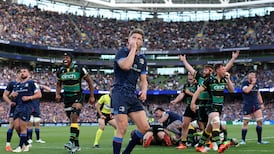Taylor Mac, star of last year's Edinburgh Festival, is reinventing drag-queen theatre with his political monologues, edgy songs and ukulele. He talks to Brian Boyd
THE newest performing artist to subvert the accepted notion of the drag queen is the US performer Taylor Mac, a big hit at last year's Edinburgh Festival and soon to begin an extensive Irish tour with his The Be(a)st of Taylor Mac show.
Speaking as he had just left the rain-soaked Glastonbury Festival, Mac's most pressing concern is that the next time he performs at the festival, he's going to insist on the Shirley Bassey treatment (getting a helicopter to the site and being carried everywhere to avoid mud splashes). "Glastonbury is a little insane anyway, but with all the rain and mud it was even more insane than usual," he says. "I felt that with my show, they had just thrown this play into a musical festival, so I had to elevate everything to a louder level and do a bit of screaming just to fit in. After waiting for four hours this morning in the rain and mud just to leave the festival, right now I really don't feel like ever going back again, but I will look into the Shirley Bassey model of how to do it."
Taylor Mac sometimes feels he's fighting a one-person battle to bring the concept of the drag queen performance back to its historical roots. "For most people, when they think drag queen they think a female impersonator who lip-synchs and does smutty vagina jokes. They also think bitchy queen humour and a selection of either Cher, Madonna or Kylie songs," he says. "That's what drag has been reduced to now, but if you look back, there were drag queens in ancient Greek drama and Shakespeare used them too, albeit calling them 'the fools'. Jackie Curtis was the first real performer to try and get away from that idea that you somehow had to convince the audience you were a female. You can play characters that are female, but in a way that the audience knows you are always a man."
On stage, Mac - with his Aladdin Sane style make-up, gold dreadlocks and rather fetching homemade dresses - endeavours to bring a bit more depth to the level of humour usually associated with drag queens, and if pushed by promoters to describe his act just says he's "a theatre artist working in the genre of pastiche".
His act consists of just him and his trusty ukulele going through songs and monologues. "The first big thing I'm about is wrestling the idea of drag queen entertainment back from the mainstream," he says.
"Everyone has their issue and my work is mainly about the idea of homogeneity. I find the best way to express that is by showing the full range of what a person is capable of - so it's not just bitchy humour, there's angry, sad, sweet, chaotic and kind all in the mix.
"The idea is that I'm not viewed as a man or a woman or even a clown. There is a heightened visual aesthetic, but not what people would normally get from an act of my nature. I'm not the funny man trying to be a woman."
With his breakthrough performance at last year's Edinburgh Fringe, he found that after each and every show he had people coming up to him to tell him he was not what they had expected. "It's not a late-night boozy show, and people were surprised by how political and edgy the performance was. They were obviously expecting something a bit lighter," he says. "I like to think that they might have had their preconceptions challenged and they went away knowing there was more to drag-queen work than singing along to Cher songs."
"I call what I do 'subversive jukebox material' in that I juxtapose very personal songs about my own life with very political songs about what's happening around us. I hope people are left with a sense that the best way to get to the political is through the personal and how that could impact on this whole so-called 'climate of fear' we're supposed to be living in. Essentially it's storytelling with a lot of costume changes. It is a very human show in that I don't have a big band, there's no big musical numbers and I don't hide behind the spectacle. It's just me and my ukulele trying to reconnect with the roots of drag-queen theatre. And mainly succeeding, I hope."
What a drag
There is, you'll be glad to know, a taxonomy specific to the world of drag queens. The drag queen (on a simple level - a man who dresses or "drags up" in female clothes and make-up for entertainment purposes) has to be differentiated from those who cross-dress for reasons other than entertainment value.
Not all drag queens are men and/or gay - there are drag artists of all genders and sexualities, although the term "drag king" is reserved for women who perform in male roles, while the term "faux queen" is used for women who dress in the stereotypical drag queen style.
A relatively recent phenomenon is the emergence of the awkwardly-titled "post-modern drag queen". The most famous of the PM drag queens was the late Jackie Curtis, who was immortalised in Lou Reed's Walk On The Wild Side.
More recently, the British artist The Divine David (see picure above) challenged all the assumptions of what an audience expects a drag queen to look like and talk like with his roughly-applied make-up and hard-hitting subject matter.









